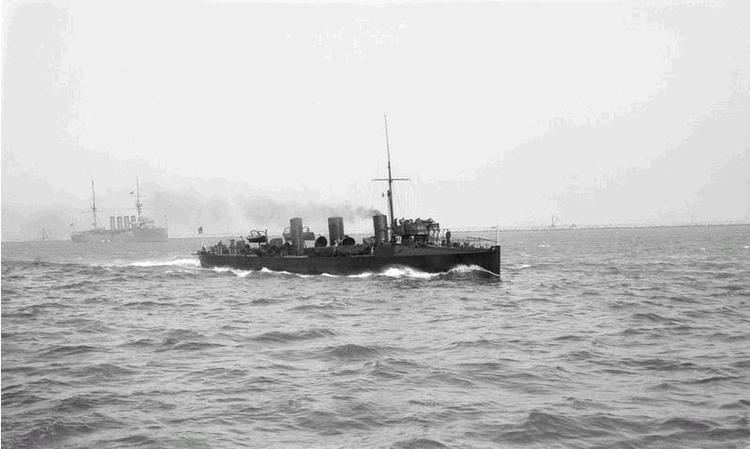Name HMS Roebuck Commissioned March 1902 Construction started 2 October 1899 | Laid down 2 October 1899 Out of service Laid up, December 1918 Launched 4 January 1901 | |
 | ||
Ordered 1898 – 1899 Naval Estimates Builder R.W. Hawthorn Leslie and Company, Hebburn-on-Tyne | ||
HMS Roebuck was a Hawthorn Leslie three-funnel, 30-knot destroyer ordered by the Royal Navy under the 1898–1899 Naval Estimates. She was the twelfth ship to carry the name. She served during World War I and was broken up in 1919.
Contents
Construction
On 30 March 1899, the British Admiralty ordered three destroyers (Roebuck, Greyhound and Racehorse) from the Newcastle shipbuilder Hawthorn Leslie, as part of the 1898–1899 shipbuilding programme.
The three ships closely resembled the two thirty-knotter destroyers, Cheerful and Mermaid built by Hawthorn Leslie under the 1896–1897 programme. They were 214 feet 6 inches (65.38 m) long overall and 210 ft 11 in (64.29 m) between perpendiculars, with a beam of 21 ft 1 in (6.43 m) and a draught of 8 ft 7 in (2.62 m). Displacement was 385 long tons (391 t) light and 430 long tons (440 t) full load. Four Yarrow boilers (in place of the Thornycroft boilers used by Cheerful and Mermaid) fed steam to two three-cylinder triple expansion steam engines, rated at 6,100 indicated horsepower (4,500 kW). Up to 85 long tons (86 t) of coal could be carried, giving a range of 1,555 nautical miles (2,880 km; 1,789 mi) at 11 knots (20 km/h; 13 mph). The ship had the standard armament of the Thirty-Knotters, i.e. a QF 12 pounder 12 cwt (3 in (76 mm) calibre) gun on a platform on the ship's conning tower (in practice the platform was also used as the ship's bridge), with a secondary armament of five 6-pounder guns, and two 18-inch (450 mm) torpedo tubes. The ship was manned by 63 officers and men.
Roebuck was laid down on 2 October 1899 at Hawthorn Leslie's Hebburn-on-Tyne shipyard and launched on 4 January 1901. She arrived at Chatham Dockyard 18 September 1901 to be armed and prepared for sea trials, during which she reached a speed of 30.346 knots (56.201 km/h; 34.922 mph). She was completed and accepted by the Royal Navy in March 1902.
Pre-war
After commissioning she was assigned to the Channel Fleet. In May 1902 she received the officers and men from the HMS Greyhound, and was commissioned by Commander Marcus Rowley Hill at Chatham for service with the Medway Instructional Flotilla. She spent her operational career mainly in home waters. In 1910, Roebuck, commanded by Andrew Cunningham, later Admiral of the Fleet and First Sea Lord, was part of the 4th Destroyer Flotilla based at Portsmouth.
On 30 August 1912 the Admiralty directed all destroyers were to be grouped into classes designated by letters based on contract speed and appearance. As a three-funneled destroyer with a contract speed of 30 knots, Roebuck was assigned to the C class. The class letters were painted on the hull below the bridge area and on a funnel.
World War I
July 1914 found her in the Portsmouth local flotilla tendered to HMS Pomone. She was deployed to Devonport under orders of the Commander in Chief, Portsmouth for the training of cadets until the Armistice.
Disposal
By December 1918 she was paid off and laid-up in reserve awaiting disposal. She was broken at Portsmouth Dockyard in 1919.
